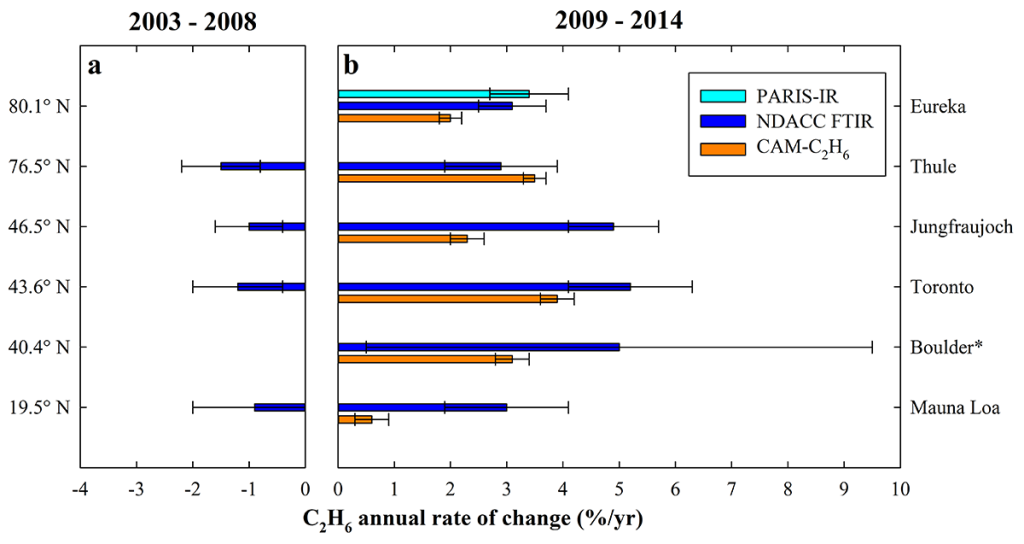
Until recently, the abundance of atmospheric ethane (C2H6) has been declining, primarily due to reduced fugitive emissions from oil and gas activities and to the successful implementation of pollution abatement measures. However, a study published early 2015 in Journal of Quantitative Spectroscopy and Radiative Transfer (doi:10.1016/j.jqsrt.2015.03.017) reported a reversal in the long-term evolution of ethane and a sharp increase of its abundance after 2009 over central Europe, using the multi-decadal ethane time series from the high-altitude NDACC site of the Jungfraujoch (Swiss Alps). Large fugitive emissions associated with the massive hydraulic fracturing and shale gas operations in the U.S. were incriminated. Simultaneously, positive anomalies of hydrocarbons related to venting, flaring and leakage from oil and gas operations were detected at U.S. locations downwind from active wells, as well as large methane emissions by space-borne remote-sensing over U.S. regions with high drilling productivity.
In a new NDACC study coordinated at the University of Liège (Belgium) and recently published in Environmental Research Letters (doi:10.1088/1748-9326/11/4/044010), consistent retrievals of ethane total columns from ground-based Fourier Transform Infrared (FTIR) observations made at five NDACC sites are used to characterize the recent ethane evolution over North America. They reveal growth rates close to 5%/yr at mid-latitudes and 3%/yr at remote sites from 2009 onwards (see Figure), corroborating the increase observed over the Jungfraujoch.
Thanks to state-of-the-art 3-D model simulations, the study further reveals that the best inventories currently available for anthropogenic emissions significantly underestimate the ethane emissions prior to 2009 by no less than a factor two. It is also shown that the North American anthropogenic annual emissions of ethane have increased by 75%, from 1.6 Tg/yr in 2008 to 2.8 Tg/yr in 2014. These figures are corroborated by satellite-based emissions of ethane from North American oil and natural gas, biofuel consumption and biomass burning inferred from GOSAT observations of methane (CH4), when using C2H6/CH4 emission ratios accounting for the natural gas composition.
These independent results contribute to underscoring the large impact of the emissions associated with hydraulic fracturing and shale gas operations in North America on the air quality degradation. Moreover, the top-down approach offers the opportunity to allocate the ethane emissions on the basis of measurements, for a more accurate representation of recent atmospheric composition changes.
Finally, this study estimates that the annual emissions of methane – the second most important anthropogenic greenhouse gas – have increased from 20 to 35 Tg/yr over the period 2008-2014, because of the expansion of oil and natural gas extraction in North America.
Reference
Franco B, Mahieu E, Emmons L K, Tzompa-Sosa Z A, Fischer E V, Sudo K, Bovy B, Conway S, Griffin D, Hannigan J W, Strong K, and Walker K A (2016) Evaluating ethane and methane emissions associated with the development of oil and natural gas extraction in North America, Environ. Res. Lett., 11, 044010, doi:10.1088/1748-9326/11/4/044010